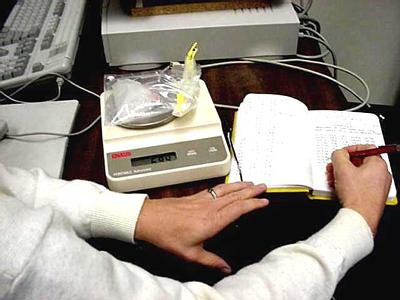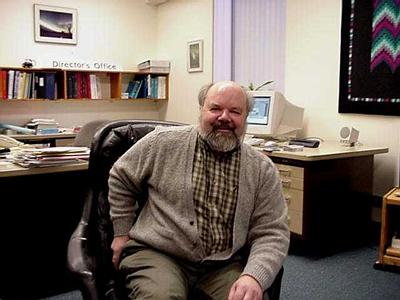19 November, 1999
Another Episode of "Magnum G.I."
SPECIAL NOTE: TODAY MARKS THE FINAL SUNSET OF THE MILLENIUM IN BARROW,
ALASKA (THE NORTHERNMOST TOWN IN THE UNITED STATES!)
It's Friday and we're back at the Geophysical Institute. Today I need to
organize and record all of our data from yesterday's work out at Poker
Flat. I will begin by determining the mass of each sample of snow (see
photo) that we collected from every 10 meter interval. As you might recall,
the densities can then be determined by dividing each snow mass by its
corresponding volume.
The mean or average snow density for a transect is plugged into an equation
in order to calculate its thermal conductivity (k).
If the snow density (p) is between 0.156 g/cc and 0.6 g/cc then the
following formula is used:
<PRE>
k = 0.138 - 1.01p + 3.233p2
If the snow density (p) is less than 0.6 g/cc, then the equation below
should be applied:
k = 0.023 + 0.234p
Now you're ready to calculate the heat flux!
heat flux = (-k)(surface temp-interface temp)/(snow depth)
</PRE>
Martin will be sending the data to me in the near future so that I can post
it on this site.
This afternoon, Martin (Dr. Jeffries) and I had the opportunity to meet
with the Director of the G.I., Dr. Roger Smith (see photos). Dr. Smith had
a great aerial photo of the Poker Flat region and we referred to it as we
discussed our lake ice-monitoring project. Thanks to Dr. Smith and to
Martin, I walked away from the meeting with a CD and hard copy of the new
"Arctic Environmental Atlas", published by the Office of Naval Research.
What a fantastic resource for the classroom! At 3:30PM Martin and I
climbed up to the roof of the G.I. so that I could get a final photo (see
below). I will say farewell to Fairbanks ("the city with a golden heart")
on Sunday, but I know that my January adventure is just around the corner!

Weighing a snow sample

Dr. Martin Jeffries

Dr. Roger Smith

Fairbanks from the roof of the G.I.
Contact the TEA in the field at
.
If you cannot connect through your browser, copy the
TEA's e-mail address in the "To:" line of
your favorite e-mail package.
|
